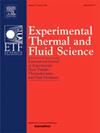Experimental study on the icing hazards over the propeller of a Low-Altitude flight UAV under changeable liquid water content environment
IF 3.3
2区 工程技术
Q2 ENGINEERING, MECHANICAL
Experimental Thermal and Fluid Science
Pub Date : 2025-06-16
DOI:10.1016/j.expthermflusci.2025.111546
引用次数: 0
Abstract
Low-altitude aerial operations frequently encounter rapidly varying ground meteorological conditions, leading to potential hazards for unmanned aerial vehicles (UAVs). To address this concern, a comprehensive experimental study was conducted to examine the icing hazards on UAV propellers, specifically in continuous and intermittent icing environments. The experiments were conducted in a specialized icing facility at Shanghai Jiao Tong University, designed to replicate flying conditions typical of UAVs, including continuous icing and intermittent precipitation scenarios. The findings reveal that, under identical durations of icing exposure, the intermittent icing environment resulted in more than 15% accumulation of ice mass on the propeller. This ice accretion led to a significant reduction in thrust coefficient, diminishing to less than 10% of its designed operational point, in contrast to a thrust coefficient of more than 16% observed under continuous icing conditions. Consequently, these results indicate that intermittent precipitation presents a greater hazard to UAV operations. Further analysis suggests that the disparity in heat transfer mechanisms, where the cold air and the propeller substrate have a prolonged interaction with the released latent heat, contributes to differing ice shape evolution patterns. This phenomenon resulted in a heightened local water collection rate during intermittent icing episodes, attributed to a reduced occurrence of ice and droplet shedding. As a consequence, there was a notable accumulation of larger ice formations at the leading-edge region of the propeller, with an increase of over 33% in the windward contact area across 95% of the spanwise distribution compared to baseline conditions. The presence of such icicles is expected to exacerbate local water collection rates, thereby leading to even more severe icing events for UAVs before the onset of ice shedding.
变化液态水环境下低空无人机螺旋桨结冰危害试验研究
低空空中作业经常遇到快速变化的地面气象条件,给无人机带来潜在的危害。为了解决这一问题,进行了一项全面的实验研究,研究了无人机螺旋桨在连续和间歇结冰环境下的结冰危害。实验在上海交通大学的一个专门的结冰设施中进行,旨在复制无人机的典型飞行条件,包括连续结冰和间歇性降水场景。研究结果表明,在相同的结冰暴露时间下,间歇性结冰环境导致超过15%的冰块积聚在螺旋桨上。冰的增加导致推力系数显著降低,减小到设计工作点的10%以下,而连续结冰条件下的推力系数超过16%。因此,这些结果表明,间歇性降水对无人机操作构成更大的危害。进一步的分析表明,在传热机制上的差异,冷空气和螺旋桨基底与释放的潜热有长时间的相互作用,导致了不同的冰形演变模式。这一现象导致间歇性结冰期间当地的水收集率增加,原因是冰和液滴脱落的发生减少。结果,在螺旋桨前缘区域出现了明显的大冰层积累,在95%的展向分布范围内,迎风接触面积比基线条件增加了33%以上。这种冰柱的存在预计会加剧当地的水收集速度,从而导致无人机在冰脱落之前遭遇更严重的结冰事件。
本文章由计算机程序翻译,如有差异,请以英文原文为准。
求助全文
约1分钟内获得全文
求助全文
来源期刊

Experimental Thermal and Fluid Science
工程技术-工程:机械
CiteScore
6.70
自引率
3.10%
发文量
159
审稿时长
34 days
期刊介绍:
Experimental Thermal and Fluid Science provides a forum for research emphasizing experimental work that enhances fundamental understanding of heat transfer, thermodynamics, and fluid mechanics. In addition to the principal areas of research, the journal covers research results in related fields, including combined heat and mass transfer, flows with phase transition, micro- and nano-scale systems, multiphase flow, combustion, radiative transfer, porous media, cryogenics, turbulence, and novel experimental techniques.
 求助内容:
求助内容: 应助结果提醒方式:
应助结果提醒方式:


